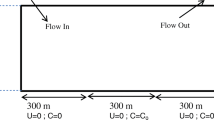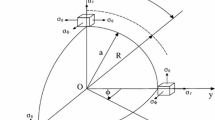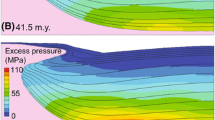Abstract
A robust 3D model of subsidence coupled with channeling into salt formations was developed. Its architecture allows easy implementation of empirical phenomenological laws regarding channel formation and subsidence within a formation. The model can be used to perform fast and adapted-to-complexity computations where data are sparse in time and space and where extensive state-of-the-art measurements are not available; as a preliminary model, it could ideally guide the development of more sophisticated, heavily parameterized and resource-demanding codes. Sensitivity analyzes on several 2D and 3D parameterizations were performed to assess the influence of several parameters in determining the shape of subsidence. The 3D finite element model coupling flow (using Darcy’s law) and subsidence (empirical models) was then tested for a French nineteenth century salt mining site, where mining may have induced subsidence by disrupting the balance between fresh water and brine. A sensitivity analysis was conducted to assess the impact of flow parameters or subsidence on results.
Zusammenfassung
Ein robustes 3D-Modell der Subsidenz gekoppelt mit Rinnenbildung in Salzformationen wurde entwickelt. Der Aufbau erlaubt die einfache Umsetzung empirischer Gesetze der Rinnenbildung und Absenkung innerhalb einer Formation. Das Modell kann benutzt werden, um schnelle und der Komplexität angepasste Berechnungen auszuführen, wenn Daten in Raum und Zeit knapp und ausgedehnte Messungen mit modernen Technologien nicht verfügbar sind; als ein vorläufiges Modell könnte es idealerweise die Entwicklung komplexerer, parameterreicher und rechenaufwendiger numerischer Berechnungen einleiten. Empfindlichkeitsberechnungen mehrerer 2D und 3D Parametervarianten erlaubten die Einschätzung diverser Parameter bei der Bestimmung der Gestalt der Absenkung. Das 3D finite Element Modell der Strömung (unter Nutzung der Darcy-Gesetze) gekoppelt mit der Absenkung (empirische Modelle) wurde an einer französischen Salzgewinnungsstätte des 19. Jahrhunderts überprüft, wo der Bergbau möglicherweise Absenkung bewirkt hat, indem das Gleichgewicht zwischen Süßwasser und Salzlauge gestört wurde. Empfindlichkeitsanalysen wurden durchgeführt, um den Einfluss von Fließparametern oder der Absenkung auf die Ergebnisse abzuschätzen.
Resumen
Se desarrolló un modelo robusto de subsidencia en 3D acoplado a la canalización en formaciones de sal. Su arquitectura permite la implementación simple de leyes fenomenológicas empíricas con respecto a la formación de canales y a la subsidencia dentro de una formación. El modelo se puede usar para realizar cómputos rápidos y adaptados a la complejidad cuando los datos son escasos en el tiempo y el espacio y las mediciones de vanguardia no están disponibles; como modelo preliminar, idealmente podría guiar el desarrollo de códigos más sofisticados, altamente parametrizados y demandantes de recursos. Se realizaron análisis de sensibilidad en varias parametrizaciones 2D y 3D para evaluar la influencia de varios parámetros en la determinación de la forma de subsidencia. El flujo de acoplamiento del modelo de elementos finitos 3D (usando la ley de Darcy) y subsidencia (modelos empíricos) fue probado para un sitio francés de minería de sal del siglo XIX, donde la minería puede haber inducido el hundimiento al interrumpir el equilibrio entre agua dulce y salmuera. Se realizó un análisis de sensibilidad para evaluar el impacto de los parámetros de flujo o la subsidencia sobre los resultados.
抽象
建立了一种耦合盐层内巷道工程的三维沉降模型。模型结构便于应用巷道形成和盐层内沉降的经验现象学定律,能够进行时间和空间数据稀疏区和大范围精确测量缺乏区的快速和适应性计算。作为基础模型,它能进一步开发成更复杂、更加参数化和数据依赖的程序。分析了二维和三维模型参数系统灵敏度,以评价几个参数对沉降盆地形态的影响。法国在19世纪所采盐矿可能已经破坏咸淡水平衡而引发地面沉降,以此为例检验了耦合水流(达西定律)和沉降(经验模型)过程的三维有限有元模型,通过灵敏度分析评价了水流和沉降参数的影响。









Similar content being viewed by others
References
Alnæs MS, Blechta J, Hake J, Johansson A, Kehlet B, Logg A, Richardson C, Ring J, Rognes ME, Wells GN (2015) The FEniCS project version 1.5. Arch Numer Softw. https://doi.org/10.11588/ans.2015.100.20553
Appelo CAJ, Postma D (2005) Geochemistry, groundwater and pollution, 2nd edn. CRC Press, Taylor & Francis, Boca Raton
Arnold DN, Brezzi F, Cockburn B, Marini LD (2002) Unified analysis of discontinuous Galerkin methods for elliptic problems. SIAM J Numer Anal 39:1749–1779
Frumkin A, Ezersky M, Al-Zoubi A, Akkawi E, Abueladas AR (2011) The Dead Sea sinkhole hazard: geophysical assessment of salt dissolution and collapse. Geomorphology 134:102–117
Guerrero J, Gutiérrez F, Lucha P (2008) Impact of halite dissolution subsidence on Quaternary fluvial terrace development: case study of the Huerva River, Ebro Basin, NE Spain. Geomorphology 100:164–179
Gutiérrez F (2004) Origin of the salt valleys in the Canyonlands section of the Colorado Plateau. Geomorphology 57:423–435
Gutiérrez F, Parise M, De Waele J, Jourde H (2014) A review on natural and human-induced geohazards and impacts in karst. Earth Sci Rev 138:61–88
Gutiérrez F, Mozafari M, Carbonel D, Gómez R, Raeisi E (2015) Leakage problems in dams built on evaporites. The case of La Loteta Dam (NE Spain), a reservoir in a large karstic depression generated by interstratal salt dissolution. Eng Geol 185:139–154
Hiller T, Kaufmann G, Romanov D (2011) Karstification beneath dam-sites: from conceptual models to realistic scenarios. J Hydrol 398:202–211
Kaufmann G, Dreybrodt W (2007) Calcite dissolution kinetics in the system CaCO3–H2O–CO2 at high undersaturation. Geochim Cosmochim Acta 71:1398–1410
Kaufmann G, Romanov D (2016) Structure and evolution of collapse sinkholes: combined interpretation from physico-chemical modelling and geophysical field work. J Hydrol 540:688–698
Mahmoudpour M, Khamehchiyan M, Nikudel MR, Ghassemi MR (2016) Numerical simulation and prediction of regional land subsidence caused by groundwater exploitation in the southwest plain of Tehran, Iran. Eng Geol 201:6–28
Malvoisin B, Podladchikov YY, Vrijmoed JC (2015) Coupling changes in densities and porosity to fluid pressure variations in reactive porous fluid flow: local thermodynamic equilibrium: reacting porosity waves. Geochem Geophys Geosyst 16:4362–4387
Nelson PH (1994) Permeability–porosity relationships in sedimentary rocks. Log Anal 35(03):38–62
Saunier M, Courrioux G (2008) Synthèse géologique du bassin salifère de Dombasle (Meurthe-et-Moselle). Final report BRGM/RP-56501-FR
Shalev E, Lyakhovsky V, Yechieli Y (2006) Salt dissolution and sinkhole formation along the Dead Sea shore: salt dissolution and sinkholes. J Geophys Res Solid Earth. https://doi.org/10.1029/2005JB004038
Trémosa J, Castillo C, Vong CQ, Kervévan C, Lassin A, Audigane P (2014) Long-term assessment of geochemical reactivity of CO2 storage in highly saline aquifers: application to Ketzin, In Salah and Snøhvit storage sites. Int J Greenh Gas Control 20:2–26
Valipour M (2016) How much meteorological information is necessary to achieve reliable accuracy for rainfall estimations? Agriculture 6:53. https://doi.org/10.3390/agriculture6040053
Viero DP, Valipour M (2017) Modeling anisotropy in free-surface overland and shallow inundation flows. Adv Water Resour 104(Suppl C):1–14. https://doi.org/10.1016/j.advwatres.2017.03.007
Waltham T, Bell FG, Culshaw MG (2005) Sinkholes and subsidence: Karst and Cavernous rocks in engineering and construction. Springer, Berlin
Yao B, Mao X, Zhang K, Cai W (2012) A non-linear fluid–solid coupling mechanical model study for paleokarst collapse breccia pipes under erosion effect. Electron J Geotech Eng 17:277–290
Zidane A, Zechner E, Huggenberger P, Younes A (2014) On the effects of subsurface parameters on evaporite dissolution (Switzerland). J Contam Hydrol 160:42–52
Author information
Authors and Affiliations
Corresponding author
Rights and permissions
About this article
Cite this article
Vong, C.Q., Gourdier, S. & Bazargan-Sabet, B. A Robust Model Coupling Subsidence with Salt Dissolution. Mine Water Environ 38, 166–177 (2019). https://doi.org/10.1007/s10230-018-0552-y
Received:
Accepted:
Published:
Issue Date:
DOI: https://doi.org/10.1007/s10230-018-0552-y




